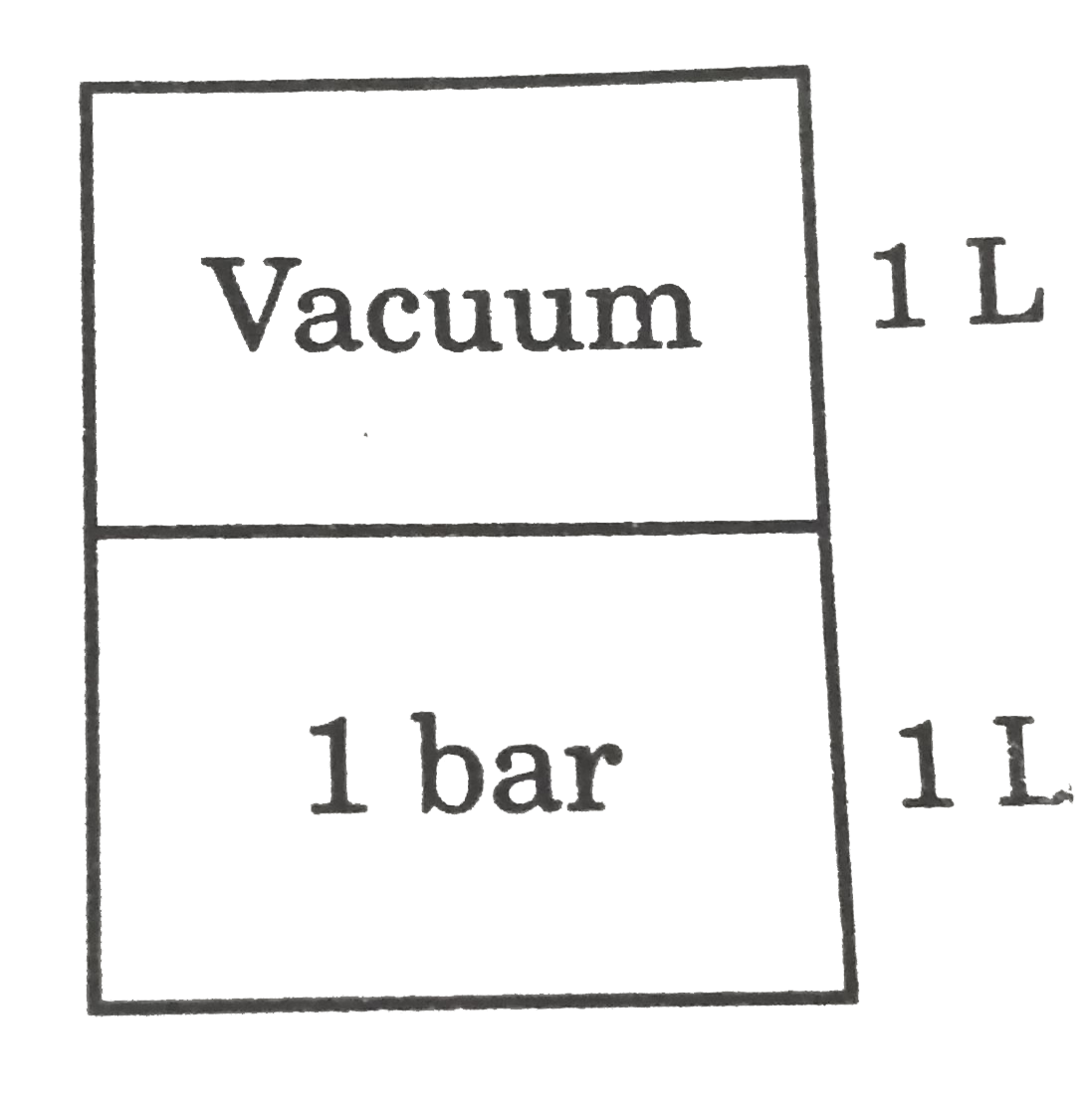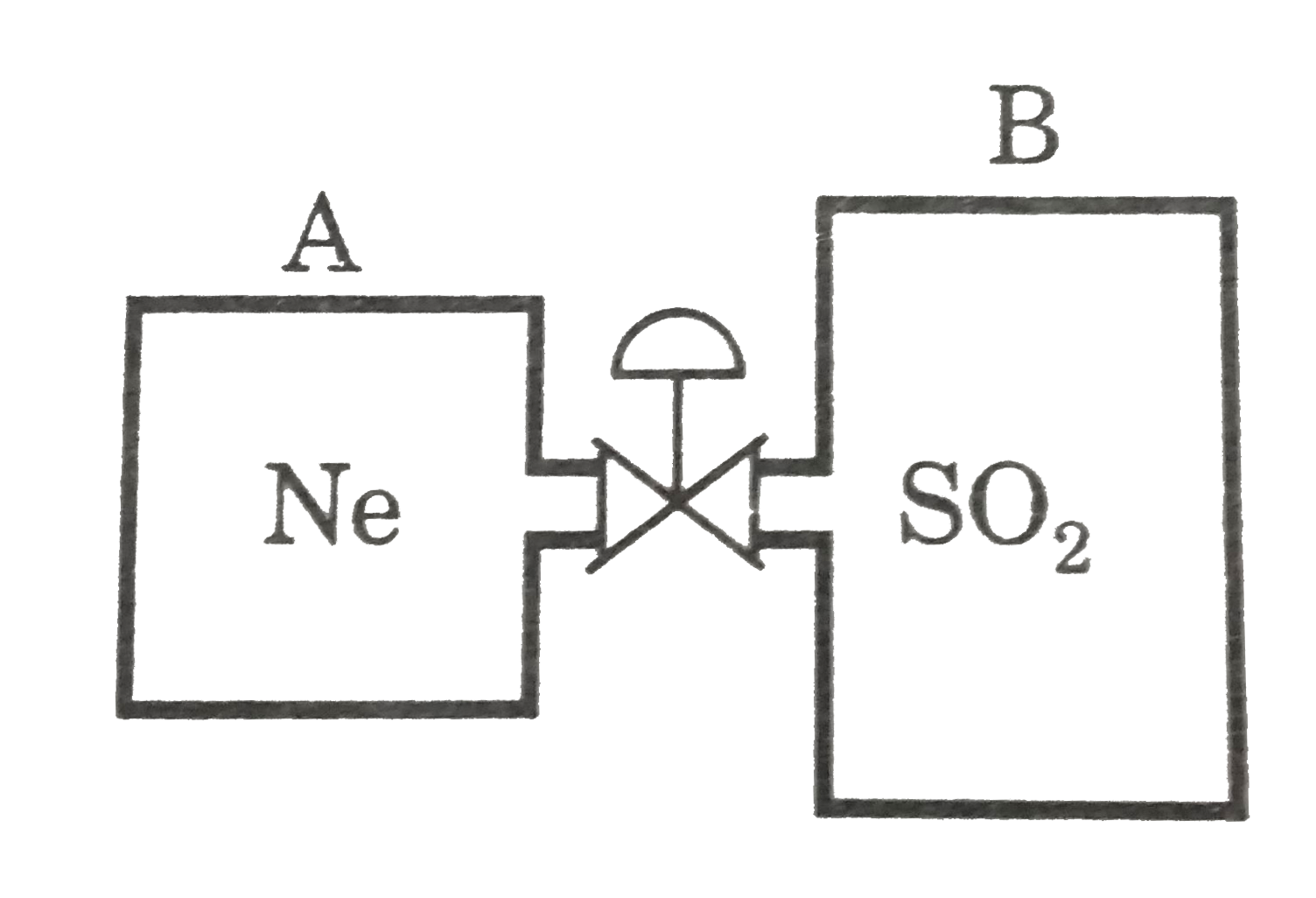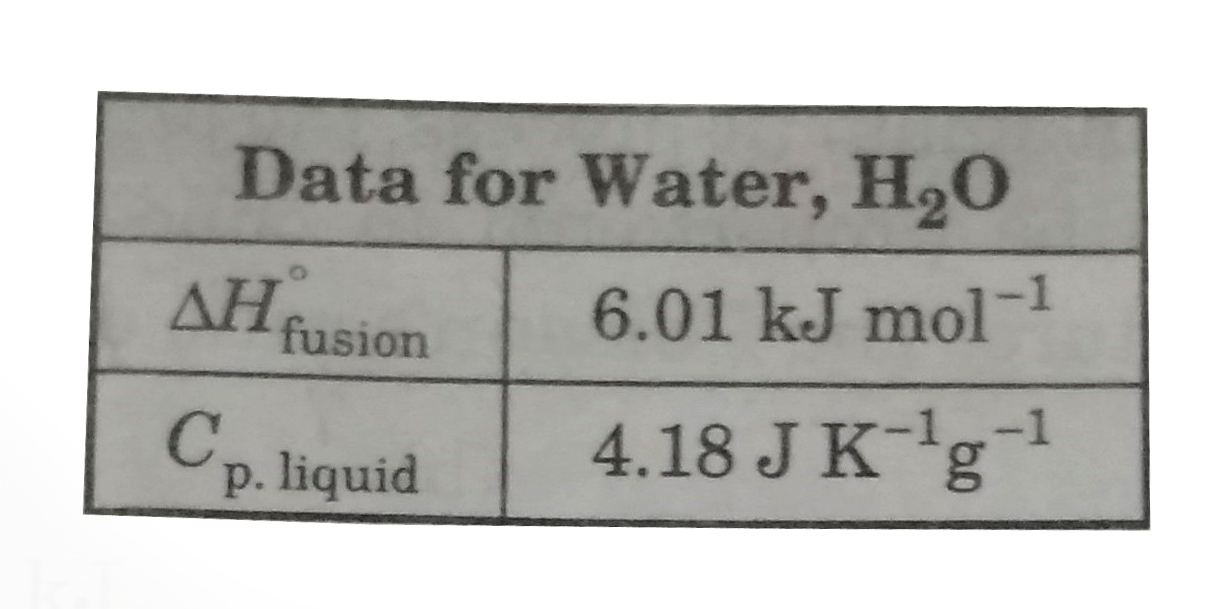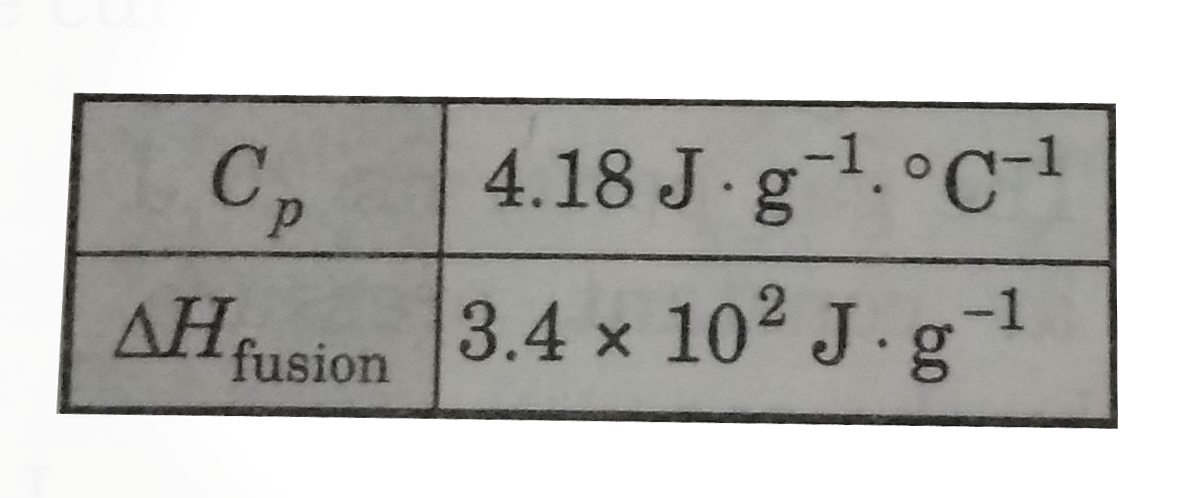Complete Solutions to All Questions of chapter THERMODYNAMICS of Class 11 book with complete answers and questions
| Class 11 | CHEMISTRY |
| Chapter | THERMODYNAMICS |
| GRB PUBLICATION | All Questions |
| Number Of Questions | 100 |
| Academic Year | 2023-24 |
1 mole of argon is expanded isothermiocally and irreversably ( not against vaccum) from 10L to 100L. Which of the following is incorrect the process ?
View SolutionSelect the correct set of `"statement"//s` :
(P) Work done by the surroundings in case of infinite stage expansion is more than single stage expansion.
(Q) Irreversible work is always greater than reversible work.
(R ) In an ideal gas in case of single stage expansion and compression, system as well as surroundings are restored back to their orginal states.
(S) If gas in thermodynamics is equilibrium is taken from state A to state B, by four successive single stage expansion. Then we can plot four points on the `P-V` indicator diagram.
View SolutionA typical adults needs 33 kcal per kg body weight per day. Assuming an energy balance, calculate the' power' of an 80 kg individual
View SolutionIn an isothermical expansion of a gaseous sample the correct relation is (consider w (work) with sign according to IUPAC convention)
[The reversible and irreversible procss are carried out between same initial and final states.]
View Solutiona monoatomic gas `(Cv=(3)/(2)R)` is allowed to expand adiabaticaly and reversibly from initial volume of 8 L to 300 K to a volume `V_(2)` at 250 K. `V_(2)` is :
View SolutionAn ideal gas with `C_(v)=3 R` expands adiabatically into a vaccum thus doubling its volume. The final temeperature is given by :
View SolutionWhat is the work done against the atmosphere when 25 grams of water vapourizes at 373 K against a constant external pressure of 1 atm ? Assume that steam obeys perfect gas laws. Given that the molar enthalpy of vaporization is `9.72 kcal//"mole"`, what is the change of enternal energy in the above process? [Take R =`2cal//mol//K`]
View SolutionA certain mass of gas expanded from ( 1L, 10 atm) to (4 L, 5 atm) against a constant external pressure of 1 atm. If initial temperature of gas is 300 K and the heat capacity of process is `50 J//^(@)C`. Then the enthalpy change during the process is :
(`1"L" "atm" underline ~ 100 J`)
View SolutionA container of volume 2L is seperated into equal compartments. In one compartment, one mole of an ideal monoatomic gas is filled at 1 bar pressure and the other compartment is completely evacuted. A pihole is made in the seperator so gas expands to occupy full 2 L and heat is supplied to gas so that finally pressure of gas equals 1 bar. Then :

View SolutionWhich of the following options is not correct w.r.t. van der Waal's gas subjected to isothermal process?
View Solution5 moles of an ideal monoatomic gas absorbes x joule when heated from `25^(@)` C to `30^(@)` C at a constant volume. The amount of heat absorbed when 2 moles of the same gas is heated from `25^(@)` C to `30^(@)` C at constant pressure, is :
View SolutionThe only incorrect statement for the value of `gamma` for `NH_(3)` gas is :
(Assume ideal gas behaviour)
View SolutionFor a gaseous reaction,
`2SO_(2)+O_(2)to2SO_(3),DeltaH=-440kJ//"mole"`
at a temperature of 300 K. Calculate `DeltaU` when 1 mole of `SO_(2)` is completely reacted with 1 mole of `O_(2)` in a 10 litre rigid vessel at an initial pressure of 50 bar which decreases to 20 bar.
View SolutionFor which of the following process `abs(DeltaH)ltabs(DeltaE)` :
View SolutionFor a fixed amouunt of an ideal gas`(gamma=(11)/(9))`, the change in internal energy of the gas when pressure changes from 10 bar to 20 bar in rigid vessel of volume 5 L is given by :
View SolutionCalculate change in enthalpy when 2 moles of liquid water at 1 bar and `100^(@)` C is coverted into steam at 2 bar and `300^(@)`. Assume `H_(2)O` vapoures to behave ideally.
[Latent heat of vaporisation of `H_(2)O(l)` at 1 bar and `100^(@)` C id=s 10.8 kcal per mole]
[R=`2cal//"mol" K`]
View SolutionWhich of the following statement is incorrect regarding adiabatic and isothermal processes for an ideal gas, starting from same initial state to same final volume?
View SolutionCalculate work involved in compression of 2 moles of `H_(2)` gas reversibly and isothermically from 1.2 L to 0.6 L at 300 K, if critical volume of `H_(2)` gas is `0.3L//"mol"`.
Given : R=`2cal//mol`,in10=2.3,log4=0.6,log5=0.7,log11=1.2]
View SolutionCaalculate `DeltaH`when 2 moles of solid benzoic acid undergo complete combustion at 300 K if
`C_(6)H_(5)COOH(s)+(15)/(2)O_(2)(g)to7CO_(2)(g)+3H_(2)O(l)`
`DeltaU_(reaction)=-750kJ//"mole"`
View SolutionFor the combustion of `CH_(4)` at 1 atm pressure and 300 K, which of the following options is correct?
View SolutionA certain mass of a gas is expended from [2 L, 20 atm, 300 K] to [5 L, 10 atm, 320 K] against a constant external pressure of 5 atm. If heat capacity of the gas is `100J//^(@)C` then enthalapy change of the process will be : [1 atm lit. = 100 J]
View SolutionThe value of `DeltaH-DeltaU` when 2 moles of solid benzoic acid undergoes combustion at 300 K is given by :
View SolutionWhat will be the value of maximum work one by the gas when pressure of 20 gm `H_(2)` is reduced from 20 to 2 atm at constant tempreature of 300 k, assuming gas to behave ideally?
View SolutionAn ideal gas is subjected to two different reversible expansion process, `PV^(3)=K_(1)` and `PV^(5//2)=K_(2)` from same initial state to same final volume. Which of the follwing statements is correct regarding the two process :
View SolutionWhich of the following options consist of only intensive parametres?
View SolutionA real gas follows PV=nRT at a temperature of `30^(@)` C. Which of the following statements is true when it is subjected to adiabatic free expansion at a temperature of `70^(@)`.
View SolutionIdentify the options in which `DeltaHgtDeltaU` . [Assume
gases to behave as ideal ].
View SolutionIn which of the following processes involving ideal gas magnitude of heat exchange will be maximum for same change in temperture and same moles.[P
is in atm and V in litre]:
View SolutionFour sample of ideal gas containig same moles and intially at same temperature and prcessure are subjected to four difference processes :
(A) Isothermal reversible expansion
(B) Isothermal irrversible expansion against final pressure
(C ) Adiabatic reversible expansion
(D) Adiabatic irreversible expansion against final pressure
If in all the cases , final pressue is same then what will be the order of final temperture in the above cases.
View SolutionAn ideal gas is expanded irrversibly against 10 bar pressure from 20 litre to 30 litre . Calculate if processure is isoenthalpic :
View SolutionThe volume of gas is reduced to half from its original volume. The specific heat will be
View SolutionFor a real gas having `a=4.105 atm -L^(2)//"mole"` and
`b=(1)/(5.4) L//"mole"` .If it is at an initial temperture of 300 k, then which of the following process can cause liquifaction of the gas ?
View SolutionWhat is the change internal energy when a gas contracts from 377 mL to 177 mL under a constant pressure of 1520 torr, while at the same time being cooled by removing 124 J heat ?
`[Take :( 1 L atm ) =100 J)]`
View SolutionThe heat capactiy of liquid water is `75.6 J//mol K`, while the enthalpy of fusion of ice is `6.0 kj//mol`. What is the smallest number of ice cubes at `0^(@)` C, each containing 9.0 g of the of water, needed to cool 500 g of liquid water from `20^(@)`C to `0^(@)`C ?
View SolutionTwo rigid adiabatic vessel A and B which initially ,contain two gases at different temperature are connected by pipe line with value of negligible volume .The vessel A contain 2 moles Ne gas `(C_(p.m)=(5)/(2)R)` at 300 K, vessel B contain 3 moles of `SO_(2) gas (C_(p.m)=4 R)` at 400 K .
The volume of the A and B vessel is 4 and 6 litre repectively .
The final total pressue (in atm ) when valve is opened and 12 kcal heat supplied throught it to vessels .
[Use :` R =2 cal //"mole" K "and" R=0.08 L . atm//"mole"` K as
per desire ]

View SolutionWarming ammonium chloride with sodium hydroxide in a test tube is an example of :
View SolutionOut of boiling point (P), entropy (Q), pH (R ) and e.m.f. of cell (S), intensive properties are:
View SolutionIce-water mass ratio is maintntained as `1:1` in a given system containing water in equilibrium with ice at constant pressue . If `C_(p)` (ice) =`C_(p)` (water) =4.18 J `mol^(-1)K^(-1)` molar heat capacity of such a system is :
View SolutionA piece of zinc at a tempreature of `20.0^(@)` C weighing 63.38 g is drooped into 180 g boiling water `(T= 100^(@)C`) . The specific heat of zinc is `0.400 Jg^(-1@) C` and that of water is `4.20 Jg^(1@) C` . What is the finial comman temperature reached by both the zinc and water ?
View SolutionTwo mole of an ideal gas is heated at constant pressure of one atmosphere from `27^(@)C` to `127^(@)C`. If `C_(v,m)=20+10^(-2)"T JK"^(-1).mol^(-1)`, then q and `DeltaU` for the process are respectively:
View SolutionDetermine which of the following reactions at constant pressure represent surrounding that do work on the system environment :
(P) `4NH_(3)(g) + 7O_(2)(g) to 4 NO_(2)+ 6H_(2)O(g)`
(Q) `CO.O(g)+ 2H_(2)(g) to CH_(3)OH(l)`
(R) `C("s,graphite")+H_(2)O(g) to CO(g)+H_(2)(g)`
(S) `H_(2)O(s) to H_(2)O(l)`
View SolutionA sample of liquid in a thermally insulated constant ( a calorimetre ) is strirred for 2 hr. by a mechancal linkage to motor in the surrounding ,for this procees :
View Solution10 mole of ideal gas expand isothermally and reversibly from a pressure of `10atm` to `1atm` at `300K`. What is the largest mass which can lifted through a height of `100` meter?
View SolutionA gas expands adiabatically at constant pressure such that `TpropV^(-1//2)`. Thre Value of `gamma(C_(p,m)//C_(v,m))` of the gas will be :
View SolutionWhich has maximum internal energy at `290K` ?
View Solution`100mL` of a liquid is contained in an insulated container at a pressure of 1bar. The pressure is steeply increased to `100`bar. The volume of the liquid is decreased by `1mL` at this constant pressure. Find `DeltaH` and `DeltaU`.
View SolutionConsider the reaction at 300 K
`H_(2)(g)+Cl_(2)(g)to2HCl(g), DeltaH^(@)=-185kJ`
If 2 mole of `H_(2)` compeletely react with 2 mole of `Cl_(2)` to form `HCl`. What is `DeltaU^(@)` for this reaction ?
View SolutionFor the real gases reaction,
`2CO(g)+O_(2)(g)to2CO_(2)(g),DeltaH=-560 kJ.` In 10 litre rigid vessel at 500 K the initial pressure is 70 bar and after the reaction it becomes 40 bar. The change in internal energy is :
View SolutionCorrect statements about samples of ice and liquid water at `0^(@)` C include which of the following ? (P) Molecules in ice and liquid water have the same kinetic energy.
(Q) Liquid water has a greater entropy than ice. (R ) Liquid water has a greater potential energy than ice
View SolutionA heating coil is immersed in a 100 g sample of `H_(2)O` (l) at a 1 atm and `100^(@)` C in a closed vessel. In this heating process , `60%` of the liquid is converted to the gaseous form at constant pressure of 1 atm . The densities of liquid and gas under these conditions are 1000 `kg//m^(3)` and 0.60 `kg//m^(3)` respectively . Magnitude of the work done forthe process is :
(Take : 1L-atm= 100J)`
View Solution10 itres of monoatomic gas at `0^(@)` C and 10 atm pressure is suddenly released to 1 atm pressure and the gas expands adibatically against the constant pressure. The final temperature and the volume of the gas respectively are :
View SolutionConsider a classroom that is roughly `5mxx10mxx3m`. Initially `T=27^(@)`C and p=1 atm. There are 50 people in a insulated class losing energy to the room at the average rate of 150 Watt per person. How long can they remain in class if the body temperature is `42^(@)` C and person feels uncomfortable above this temperature. Heat capacity of air=`(7//2)R`
View SolutionThe increase in internal energy of 1 kg of water at `100^(@)` C when it is converted into steam at the same temperature and 1 atm (100 kPa) will be :
[The density of water and steam are `1000 kg//m^(3) "and" 0.6 kg//m^(3)` respectively. The latent heat of vapourisation of water is `2.25xx10^(6) J//kg`.]
View SolutionAt `5xx10^(4)` bar pressure density of diamond and graphite are `3 g//c c` and `2g//c c` respectively, at certain temperature `'T'`.Find the value of `DeltaU-DeltaH` for the conversion of 1 mole of graphite to 1 mole of diamond at temperature `'T' :`
View SolutionA new flourocarbon of molar mass 102 g `mol^(-1)` was placed in an electricity heated vessel. Whwn the pressure was 650 torr, the liquid boiled at `77^(@)` C. After the boiling point had been reached , it was found that a current of 0.25 A from a 12.0 volt supply passed for 600 sec vaporises 1.8g of the sample. The molar enthalpy and enternal energy of vaporisation of new flourocarbon will be :
View SolutionThe molar heat capacity, `C_(v)` of helium gas is `3//2` R and is independent of temperature. For hydrogen gas, `C_(v)` approaches `3//2` R at a very low temperature, equals `5//2` R at moderate temperature and is higher than `5//2` R at high temperature. Choose the correct reason for the temperature dependence of `C_(v)` in case of hydrogen :
View SolutionThe ratio of P to V at any instant is constant and is equal to 1. for a monoatomic ideal gas undergoing a process. What is the molar heat capacity of the gas?
View SolutionAn ideal gas expands from `1xx10^(-3)m^(3)` to `1xx10^(-2)m^(3)` at `300K` againts a constant pressure of `1xx10^(5)Nm^(-2)` . The work done is :
View SolutionConsider the reaction: `N_(2) + 3H_(2) hArr 2NH_(3)` carried out at constant pressure and temperature. If `DeltaH` and `DeltaU` are change in enthalpy and change in internal energy respectively, then:
View SolutionAn ideal gas is allowed to expand both reversible and irreversibly in an isolated system. If `T_(i)` is the initial temperature and `T_(f)` is the final temperature, which of the following statements is correct:
View SolutionWhat is the change in enthalapy (kcal) when 1 mole of ideal monoatomic gas is expended reversibly and adibatically from initial volume of 1 L and initial temperature 300 K to final volume of 8 L :
View SolutionOne mole of a monoatomic ideal gas initially at a pressure of 2.00 bar and a temperature of 273 K is taken to a final pressure of 4.00 bar by a reversible path defined by `P//V`=constant, the value of `DeltaU//w` for this process is :
View SolutionThe temperature of a definite amount of an ideal monoatomic gas becomes four times in a reversible process for which heat exchange is zero. Which of the following is correct relation between the final and initial parameteres of gas?
View SolutionCalculate the work done on the system in Joules when 2.0 moles of `N_(2)` reactes with 6.0 moles `H_(2)`, to form `NH_(3)` against a pressure of 1 .0 atm at `27^(@)` C. `N_(2)(g)+3H_(2)(g)to2NH_(3)(g)`
(Given : R= `8 J//mol K`)
View SolutionA certain mass of an ideal gas absorbes 80 kJ heat and gas is expended from 2 L to 10 L at constant pressure of 25 bar. What is `DeltaU` for gas in the process ? ( 1 bar-L= 100 J)
View SolutionFor which of the following change `DeltaHneDeltaE`?
View SolutionSelect the correct formula for isothermal irreversible process for an ideal gas :
View SolutionWhen 1 mol of real gas absorbes 100 kJ heat at constant pressure of 1 bar, it’s volume changes from 2 L to 2.5 L. What is the enthalapy for the gas?
View Solution418.4 J of heat is added to a `4xx10^(-3)m^(3)` rigid container containing a diatomic gas atm and 273 K. Calculate the pressure of the gas assuming ideal behaviour. The vibrational contributions may be neglected : (R=8.314 J `mol^(-1) K^(-1)`)
View SolutionGiven at `25^(@)` C
`4NH_(3)(g)+5O_(2)(g)hArr6H_(2)O(l)+4NO(g)`,
`DeltaH^(@)=-1169 kJ mol^(-1)`
The value of `DeltaU^(@)` for this reaction at `25^(@)` C will be about :
View SolutionGiven at 300 K
`NH_(3)(g)hArr(1)/(2)N_(2)(g)+(3)/(2)H_(2)(g)`,
`Delta_(r)H^(@)=193.27kJmol^(-1)`
The value of `Delta_(r)U` for this reaction would be :
View SolutionOne mole of diatomic ideal gas undergoing a process in which absolute temperature is directely proportional to cube of volume, then, heat capacity of process is :
View SolutionCalculate `DeltaU` for a gas, if enthalpy change is 40 atm-L for the state change (5 atm, 10 L) to (3 atm,15 L) :
View SolutionMaximum heat absorbed during isothermal expansion of an ideal gas from (10 atm, 1 L) to (1 atm, 10 L) is :
View Solution1 mole of an ideal gas expands from `5 dm^(3) " to" 25 dm^(3)` isothermally and irreversibly at `27^(@)` C. Find work done in the process [R=8.3 `J//mol//K`]
View SolutionWhich of the following statements is correct ?
View SolutionThermodynamics is not concerned about….
View SolutionThe volume of gas is reduced to half from its original volume. The specific heat will be
View SolutionDuring an experiment an ideal gas is found to be obey an additional law `PV^(3)`= Constant. The initial temperature of gas is 600 K, what will be the final temperature, if gas expands to double it's volume :
View SolutionA gas expands slowely against a variable pressure given by `p=(10)/(V)` bar, where V is the volume of gas at each stage of expansion. During expansion from volume 10 L to 100 L the gas undergoes an increase in internal energy of 400 J. How much heat is absorbed by gas during expansion ?
View SolutionA system is provided 50 J of heat and work can be done on the system is 10 J. The change in internal energy during the process is:
View SolutionTemperature of `1mol` of a gas is increased by `1^(@)` at constant pressure. The work done is
View SolutionIn an adibatic process, no transfer of heat takes place between system and surroundings. Choose the correct option for free expansion of an ideal gas under adiabatic conditions from the following :
View SolutionThe pressure-volume work for an ideal gas can be calculated by using the expression `omega=-underset(upsilon_(1))int overset(upsilon_(1))P_(ex)dV.` The work can also be calculated form the Pv, plot by using the area under the curve within the specified limits. When an ideal gas is compressed (a) reversiblity or (b) irrevesibly form volume `V_(i) "to"V_(f)` choose the correct option:
View SolutionWork done by a sample of an ideal gas in a process A is double the work done in another process B. The temperature rises through the same amount in the two process. If `C_(A)and C_(B)` be the molar heat capacitites for the two processes:
View SolutionOne mole of a real gas is subjective to a process form `(2"bar",30lit,300k)` to `(2"bar",50lit,400k)` Given `C_(v)=40J//mol//K,C_(P)=50J//mol//K` Calculate `triangleU`.
View SolutionAn ideal gaseous sample at intial state `i(P_(0),V_(0),T_(0))` is allowed to expand to volume `2 V_(0)` using two different process, in the first process, thje equation of process is `2PV^(2)=K_(1)` and in the second process the equation of the process is `PV=K_(2)`. Then:
View SolutionA balloon is 1m in diameter and contain air at `25^(@)C` and 1 bar pressure. It is filled with air isothermally and reversibly until the pressure reaches 5bar. Assume pressure is propotional to diameter of ballon. Calulate work done by air `(atm ,m^(3))`
View SolutionDuring an adiabatic process, the pressure of a gas is found to be proportional to cube of its absolute temperature. The poision's ratio of gas is:
View SolutionCalulate the work done (in cal.). When 1.0 mole of `N_(2)H_(4)` decomposes completely against a pressure of `1.0` atm at `27^(@)C` `(Given R=2 cal//mol//K)`
`N_(2)H_(4)(l)toNH_(3)(g)+N_(2)(g)`
View SolutionThe average degree of freedom per molecule for a gas is 6. The gas performs `25J` of work when it expands at constant pressure. Find the heat absorbed by the gas:
View SolutionIn which of the following chemical reactions, `deltaHgtdeltaU?`
View SolutionIn a constant pressure process, for 5mole of an ideal monoatomic gas, the temperature of gas increased form `300K to 500k`. Which of the following is incorrect reagarding the process?
View Solution`delta_(f) U^(Ө) "of formation of" CH_(4)(g)` at a certain temperature is `-393Jmol^(-1).` The value of `delta H^(Ө)is:`
View SolutionWhat is correcto for an ideal gas undergoing reversible adiabatic expansion reagarding temperture?
View SolutionAn ideal gas taken in an insulated chamber is relased into interstellar space. The statement that is nearly trure for this pupose is :
View SolutionHow much energy must be supplied to change `36g` of ice at `36g` of ice at `0^(@)C` water at room temperture , `25^(@)C?`

View SolutionA certain reaction is exothermic by `220kJ ` and does `10kJ` of work. What is the change is the internal energy of the system at constant temperture?
View SolutionCalculate the amount the energy necessary to heat a `2.5g` ice cube form `0^(@)C "to" 23^(@)C:`

View Solution`deltaE^(@)` is measured at constant volume and `deltaH^(@)` is measured at constant pressure. For the reaction ,
`2C(s)+O_(2)(g)to2CO(g)` " " `deltaH^(@)lt0kJ`
How do the `deltaE^(@)and deltaH^(@)` compare for this reaction ?
View Solution
All Questions questions and complete solutions for chapter THERMODYNAMICS of GRB CHEMISTRY (HINGLISH) of Class 11